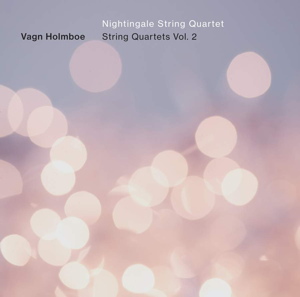
Vagn Holmboe (1909-1996)
String Quartets Volume 2
String Quartet No. 2 Op. 47 (1949)
String Quartet No. 14 Op. 125 (1975)
Quartetto sereno Op. 197 posth., completed by Per Nørgård (1996)
Nightingale String Quartet
rec. 2020, Studiescenen, The Royal Danish Academy of Music, Copenhagen, Denmark
Dacapo 6.220717 SACD [56]
The Kontra Quartet recorded Vagn Holmboe’s string quartets for Dacapo in 1993-2000. A second cycle is under way, by the all-female Nightingale Quartet (a decade ago they recorded with success Holmboe older contemporary Rued Langgaard’s quartets – review). The label may be after better sound, because the Kontra discs, especially the earlier ones, sound thin and lack warmth. The interpretation in the new versions is to be preferred sometimes but not always; see a review of the first volume.
The Quartetto Sereno is effectively Quartet No. 21. Holmboe, sadly, never completed it. It was left to Per Nørgård – his one-time pupil and, mostly, friend – to assemble the sketches of the Allegro second movement. It is good that he did but I do not feel that it makes a successful piece. Holmboe probably would have worked on it much more. By the time the Kontra Quartet reached this piece, their recorded sound had much improved. Both performances are convincing. One might hear the Adagio first movement as Holmboe’s farewell to a life fulfilled, with calm acceptance.
Quartet No. 14 is a six-movement work with superbly balanced material. The first two movements are played with mutes, the third is a sort of ostinato. The fourth, an Adagio, is richly elegiac, the fleeting fifth is played entirely pizzicato. The final movement, Allegro vivace, is a total contrast, full of nervous energy. As the booklet says, it seems as if the music has “woken from the world of dreams”. The Kontra Quartet had a stronger sense of direction and energy, but I like the emphasis on a dreamier landscape that the new recording captures.
I think music students should have on their shelves Holmboe’s book Experiencing Music (Toccata Press 1991). He writes how the String Quartet No. 14 gradually came into being (p. 44). He admits to mostly composing at the piano but he says (p. 45) that he does “not basically hear it as an instrument […] because in my inner ear I heard only the sound of the instruments for which I was writing”. That rings true for me. It would account for Holmboe’s ability to compose so idiomatically for strings. This is no more so than especially in the first movement and the Scherzo third movement of Quartet No. 2, the longest work here. Its two opening movements take up well over half of its length. The second and fourth movements are deeply elegiac. The finale is mostly in a dancing quintuple time.
To talk about Holmboe’s music in broader terms, his first nine symphonies and his first twelve quartets can tend towards the aggressive and sometimes combative. His later works, however, bring a serenity and stillness quite unlike any other. Such differences can be heard in these three works.
The booklet notes for the older cycle are much more detailed and helpful. I also like it that they brought out the works more or less chronologically. I also admire the way they attack Holmboe’s often wiry counterpoint. On the other hand, I feel the Nightingale Quartet capture more of the spirituality of the music. They remind me of a visit I made in September 2021 to the village in Jutland near to where Holmboe had lived his final years. I ambled through the simple, tranquil landscape, partially tree-lined but with intimate pastoral views. They seemed to sum up the delicate beauty of much of his music with its closeness to nature, alongside harshness and brutality.
Gary Higginson
Previous review: Jonathan Woolf (January 2023)
Help us financially by purchasing from





















